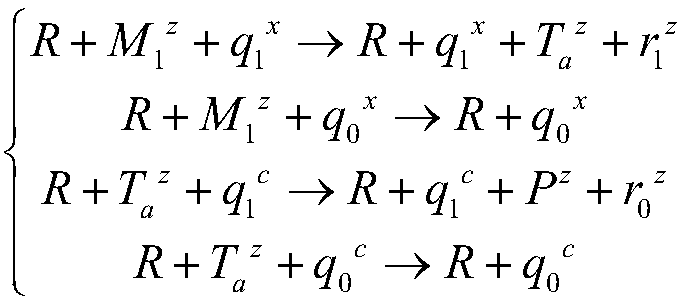Low density parity check code decoding method based on chemical reaction network
A chemical reaction network and low-density parity technology, applied in the field of low-density parity-check code decoding, can solve problems such as low-density parity-check codes that have not yet appeared, and achieve the effect of low calculation energy consumption
- Summary
- Abstract
- Description
- Claims
- Application Information
AI Technical Summary
Problems solved by technology
Method used
Image
Examples
Embodiment Construction
[0040] The technical solution of the present invention will be further introduced below in combination with specific implementation methods and accompanying drawings.
[0041] This specific embodiment discloses a low-density parity-check code decoding method based on a chemical reaction network, such as figure 1 As shown, for the j-th check node connected to the i-th 1 i 2 and i 3 In the case of data nodes, the following calculations are performed:
[0042] 11) Use z, x and c in formula (1) as z=j·i 1 , x=i 2 · j and c = i 3 Substitute j for calculation;
[0043] 12) Use z, x and c in formula (1) with z=j·i 2, x=i 1 · j and c = i 3 Substitute j for calculation;
[0044] 13) Use z, x and c in formula (1) as z=j·i 3 , x=i 2 · j and c = i 1 Substitute j for calculation;
[0045] Wherein, formula (1) that 11), 12) and 13) are aimed at is:
[0046] R+M z →R+M 1 z +M 2 z +M 3 z +M 4 z
[0047]
[0048]
[0049] Bringing in three times generates three g...
PUM
 Login to View More
Login to View More Abstract
Description
Claims
Application Information
 Login to View More
Login to View More - R&D
- Intellectual Property
- Life Sciences
- Materials
- Tech Scout
- Unparalleled Data Quality
- Higher Quality Content
- 60% Fewer Hallucinations
Browse by: Latest US Patents, China's latest patents, Technical Efficacy Thesaurus, Application Domain, Technology Topic, Popular Technical Reports.
© 2025 PatSnap. All rights reserved.Legal|Privacy policy|Modern Slavery Act Transparency Statement|Sitemap|About US| Contact US: help@patsnap.com



